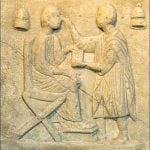Chapters
In ancient Rome, war was an integral part of life, and the Roman army enjoyed a reputation as one of the best-organized military forces in history. To maintain their power on the battlefield, the Romans also had to develop medical skills that allowed them to effectively treat wounded soldiers and ensure a quick return to combat. Field medicine in ancient Rome was therefore a key element of their war strategy.
Medical organization in the Roman army
One of the most important factors that contributed to the effective treatment of the wounded was the carefully organized medical structure in the army. This structure was headed by milites medici, i.e. doctors whose task was to dress wounds on the battlefield and organize field hospitals, called valetudinaria. Valetudinaria were created in permanent legion camps and some cities. They were built thoughtfully, with separate rooms for the sick and injured, which enabled more effective treatment and isolation of people suffering from infectious diseases.
Valetudinaria were often well-stocked and had separate sections for treating different types of injuries, allowing doctors to operate more efficiently. They were one of the first medical institutions of such a scale in history, and their concept influenced the development of later hospitals in Europe. Importantly, these hospitals served mainly soldiers, emphasizing the military nature of Roman medicine.
Some of the larger military camps had permanentvaletudinarias (singular valetudinarium) that were fully equipped with appropriate tools, as well as beds for the wounded. Valetudinaria were crucial to the care of the wounded, but the most important on the battlefield were the capsarii – medics who were responsible for quickly providing aid, dressing wounds and transporting the wounded to safer places.
Military doctors were well-trained due to their experience with many wounds, and their medical knowledge often came from both Greek and Egyptian traditions.
Treatments, anaesthetics and medical tools
Due to their lifestyle, constant wars, battles and conquests, dressing the wounded was almost a daily occurrence for the Romans. The ancient physician Galen is said to have learned certain surgical procedures while caring for wounded gladiators. Each legion had its own medical team qualified to treat wounds and injuries suffered during military service. Medics were able to make a diagnosis about the danger posed by a specific wound, when to leave the spear in the body, and when to try to remove it. The legions also had their own, well-equipped hospitals. In one of them, located near the Germanic border, archaeologists discovered hearths in which surgical instruments were sterilized.
The most complete picture of the work of Roman surgeons is provided by a treatise by Cornelius Celsus concerning medical procedures. According to the advice of the ancient physician, the surgeon should be young, have a strong, efficient and steady hand and excellent eyesight, and should never give up. He must feel compassion for his patients, but at the same time maintain a distance that will allow him to become immune to the moaning. Otherwise, he might be pressured to work faster and therefore less precisely or not cut deep enough.
Roman doctors were also familiar with anaesthetics. Particularly recommended herbs were: black henbane and opium poppy. However, the most important thing was to perform the surgery as quickly as possible, not to relieve the patient’s pain. The surgeon also had to have good and strong assistants who could sometimes be needed to hold the struggling patient. Celsus lists over a hundred different instruments used by ancient physicians. Interestingly, many of them are used in modern medicine, such as: scalpels, catheters, probes, forceps, special tools with hooks used to remove tips, as well as pliers for extracting teeth, and some of them, e.g. catheter and speculum, have survived to this day unchanged. Hooks were also used to move tendons and blood vessels away during surgery. These tools were designed with extreme care and consideration of the purpose of use – from removing cataracts to operating on haemorrhoids.
Roman doctors often used sophisticated methods of stopping bleeding, such as cauterization (burning the wound with hot metal). Tools used in the ancient cauterization process included heated lances and knives. A piece of metal was heated over a fire and placed on the wound.
The most frequently recommended medicines were various herbal mixtures and physical exercises following the saying that “a healthy mind resides in a healthy body”. In turn, cabbage and wine served as a panacea for all ailments.
The heritage of Roman medicine
The Roman art of healing on the battlefield, although based on some primitive techniques, was extremely advanced for its time. The ability to organize medical care, develop surgical knowledge and the ability to effectively treat wounded soldiers contributed to Rome’s military strength. Interestingly, many of the techniques and tools used by Roman doctors have survived centuries and influenced the development of medicine in the Middle Ages and modern times.







